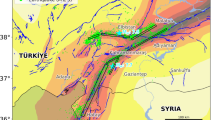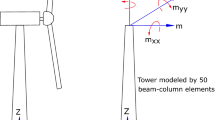Abstract
In this paper, the effect of pulse-type motions caused by forward directivity that can release huge amounts of energy in a short time period is studied on a telecommunication tower. Since telecommunication towers have longer periods, they are not as affected by seismic forces. Nevertheless, near source earthquakes characterized by high velocity and velocity pulses can change the behavior of these structures. For this reason, a telecommunication tower located near active faults was selected in this study. Considering the probable earthquake magnitude at the site and the distance of the tower from adjacent faults, nine simulated pulses and three near-fault earthquake records with forward directivity are selected and applied to a 3D finite element model of the tower. The results of nonlinear dynamic analysis, i.e., displacements and damage in the tower, indicate that the maximum displacement and drift ratio of the tower under the pulses are obviously affected by the ratio of the structure period to pulse period. When this ratio is decreased and close to 1.0, the maximum displacement and drift ratio are sharply increased and cause large displacements in the tower.
Similar content being viewed by others
References
ABAQUS (2006), ABAQUS Theory Manual and Users’ Manual, Version 6.6.
Alavi B and Krawinkler H (2000), “Consideration of Near-fault Ground Motion Effects in Seismic Design,” Proceedings of 12th World Conference on Earthquake Engineering, New Zealand.
Alavi B and Krawinkler H (2001), “Effects of Near-fault Ground Motions on Frame Structures,” Blume Center Report #138. Stanford (CA).
Ambraseys NN and Melville CP (1982), “A History of Persian Earthquakes,” Cambridge Earth Science Series, Cambridge University Press, London.
Berberian M (1994), “Natural Hazards and the First Earthquake Catalog of Iran1994,” Vol. 1, Historical Hazards in Iran Prior 1900, IIEES, Report.
Berberian M and Yeats RS (2001), “Contribution of Archaeological Data to Studies of Earthquake History in the Iranian Plateau,” Journal of Structural Geology, 23: 563–584.
Bray J and Rodriguez Mark A (2004), “Characterization of Forward-directivity Ground Motions in the Near-fault Region,” Soil Dynamics and Earthquake Engineering, 24: 815–828.
Hall JF, Heaton TH, Halling MW and Wald DJ (1995), “Near-source Ground Motion and Its Effects on Flexible Buildings,” Earthquake Spectra, 11(4): 569–605.
Lee J and Fenves GL (1998), “A Plastic-damage Model for Cyclic Loading of Concrete Structures,” Journal of Engineering Mechanics, ASCE, 124: 892–900.
Lubliner J, Oliver J, Oller S and Onate E (1989), “A Plastic-damage Model for Concrete,” International Journal of Solids and Structures, 25(3): 299–326.
Mavroeidis GP and Papageorgiou AS (2003), “A Mathematical Representation of Near Fault Ground Motions,” Bulletin of the Seismological Society of America, 93(3): 1099–1131.
Mohammadrezapour E (2007), “Effect of Near Fault Earthquakes on Semi-rigid Steel Frames,” MS Thesis, K. N. Toosi University of Technology, Tehran, Iran.
Rezayibana B (2008), “Nonlinear Dynamic Analysis of Tall Telecommunication Towers,” MS Thesis, K. N. Toosi University of Technology, Tehran, Iran.
Ritz J F, Balescu S, Soleymani S, Abbassi M, Nazari H, Feghhi K, Shabanian E, Tabassi H, Farbod Y, Lamothe M, Michelot JL, Massault M, Chery J and Vernant P (2003), “Determining the Long-term Slip Rate along the Mosha Fault, Central Alborz. Iran, Implications in Terms of Seismic Activity,” S.E.E. 4 Meeting, Tehran, 12–14 May.
Sasani M and Bertero V (2000), “Importance of Severe Pulse-type Ground Motions in Performance-based Engineering, Historical and Critical Review,” Proceedings of the 12th WCEE, Paper No. 1302, Auckland, New Zealand.
Somerville PG, Smith NF, Graves RW and Abrahamson NA (1997), “Modification of Empirical Strong Ground Motion Attenuation Relations to Include the Amplitude and Duration Effects of Rupture Directivity,” Seismological Research Letters, 68(1): 199–222.
Trifonov VG, Hessami KT and Jamali F (1996), “Westtrending Oblique Sinitral-reverse Fault System in Northern Iran,” IIEES Special Pub, Vol. 75, Tehran, Iran.
Zhang Y and Iwan WD (2002), “Active Interaction Control of Tall Buildings Subjected to Near-field Ground Motions,” Journal of Structural Engineering, ASCE, 128(1): 69–79.
Author information
Authors and Affiliations
Corresponding author
Rights and permissions
About this article
Cite this article
Yahyai, M., Rezayibana, B. & Mohammadrezapour, E. Effect of near-fault earthquakes with forward directivity on telecommunication towers. Earthq. Eng. Eng. Vib. 10, 211–218 (2011). https://doi.org/10.1007/s11803-011-0059-z
Received:
Accepted:
Published:
Issue Date:
DOI: https://doi.org/10.1007/s11803-011-0059-z




